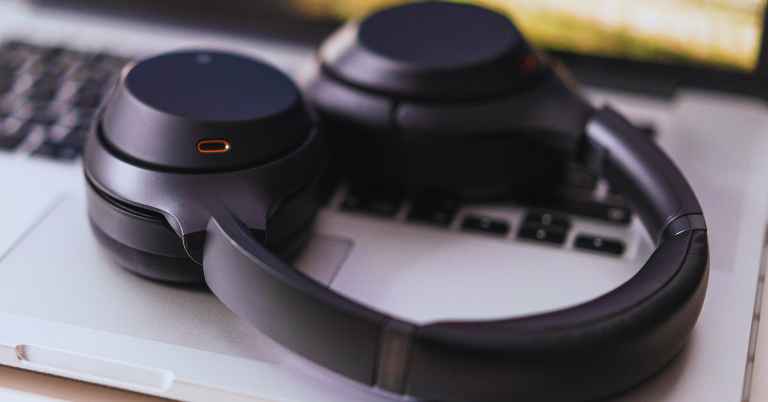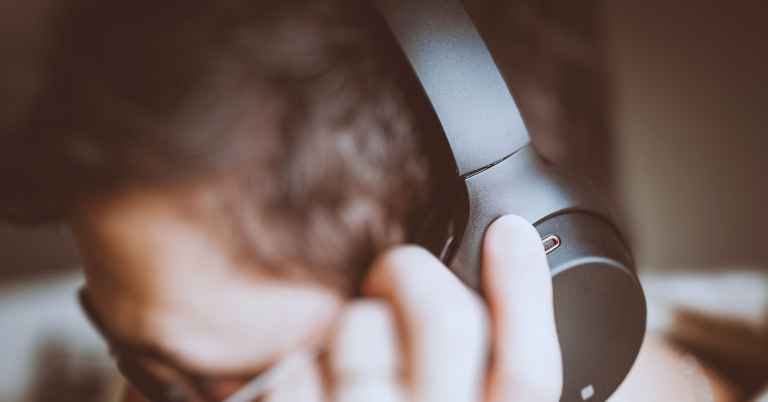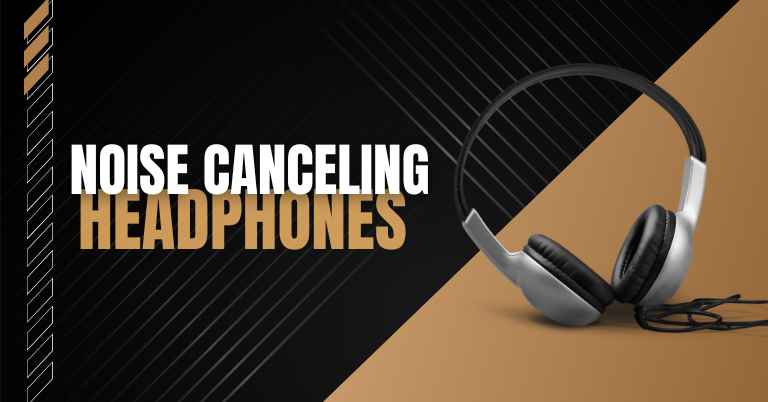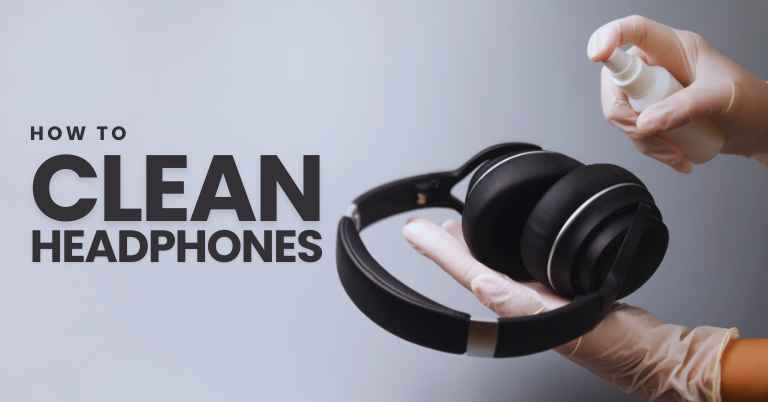Noise canceling headphones work by using built-in microphones to analyze external sounds and create corresponding sound waves that cancel out the noise, allowing the listener to enjoy a more immersive and peaceful audio experience. With noise-cancellation technology becoming increasingly popular, these headphones have become an essential tool in various situations, such as traveling, studying, or working in noisy environments.
By understanding the mechanics behind noise canceling headphones, users can make informed choices when purchasing them and enhance their overall listening experience. We will delve into the science behind how these headphones work, exploring the different types of noise cancellation and their practical applications.
The Science Behind Noise-canceling Headphones
Noise-canceling headphones work by using built-in microphones to pick up and analyze ambient noise. The headphones then produce sound waves that are the exact opposite of the detected noise, effectively canceling it out. This technology allows for a more immersive and distraction-free listening experience.
Noise-canceling headphones have become increasingly popular due to their ability to block out unwanted ambient sounds. But have you ever wondered how these headphones work?
Sound Waves And Interference
In order to understand noise-canceling headphones, it’s important to first understand sound waves. Sound travels in waves, creating vibrations that our ears interpret as sound. When unwanted sounds, such as traffic noise or chatter, interrupt our listening experience, noise-canceling headphones come to the rescue.
Noise-canceling headphones harness the power of physics to counteract these undesired sounds. They work on the principle of interference, specifically destructive interference. Destructive interference occurs when two or more sound waves of opposite phase interact, canceling each other out.
By incorporating microphones into the headphones, they are able to pick up ambient noises in their surrounding environment. These microphones detect the unwanted sounds and generate a sound wave with the opposite phase.
The inverted sound waves are then emitted through the headphones, combining with the original ambient noise. This results in destructive interference, effectively canceling out the unwanted sounds. The result? A more immersive and peaceful listening experience.
Active Noise Cancellation Technology
The technology behind noise-canceling headphones is called active noise cancellation (ANC). Unlike passive noise cancellation, which simply acts as a physical barrier to block out sounds, ANC takes it a step further by actively targeting and neutralizing these noises.
ANC employs advanced algorithms and digital signal processing to analyze the ambient noises detected by the microphones. These algorithms then generate the opposite sound wave, which is sent through the speakers of the headphones.
This technology allows noise-canceling headphones to effectively reduce low-frequency sounds, such as the rumble of an airplane engine or the droning of a nearby air conditioner. ANC is particularly useful in environments where constant background noise is present.
It’s important to note that noise-canceling headphones are most effective against continuous background noise, rather than sudden or random sounds. However, some models have improved capabilities to handle these types of interruptions, providing a more seamless listening experience.
So, the next time you put on your noise-canceling headphones, remember that there’s some fascinating science at work behind the scenes. These innovative devices not only improve your audio experience but also showcase the mastery of physics and technology.

Components Of Noise-canceling Headphones
When it comes to noise-canceling headphones, it’s the sophisticated components that make all the difference. These headphones are equipped with specific components that work together to eliminate or reduce background noise, allowing you to enjoy your music or audio without any distractions. In this post, we will dive into the key components of noise-canceling headphones and how they contribute to an immersive and uninterrupted audio experience.
Microphones
One of the essential components of noise-canceling headphones is the microphones. These tiny devices play a crucial role in capturing external sounds or ambient noise. Unlike regular headphones that solely focus on delivering audio, noise-canceling headphones feature microphones on the earcups or earbuds. These microphones pick up the unwanted sounds occurring around you, capturing all the external audio.
Once the microphones capture the surrounding sounds, they generate an electrical signal that contains the same frequency and amplitude as the incoming noise.
Noise-canceling Circuitry
Another critical component in noise-canceling headphones is the noise-canceling circuitry. This circuitry consists of intricate electronic components and algorithms that actively work to eliminate unwanted sounds. The circuitry analyzes and processes the electrical signal received from the microphones, generating an anti-noise signal with an equal frequency and opposite amplitude.
This anti-noise signal is then mixed with the desired audio signal, effectively canceling out the external noise. By using advanced technology, noise-canceling headphones can achieve impressive noise reduction, creating a peaceful audio environment.
It’s crucial to mention that noise-canceling circuitry can vary in complexity and quality between different headphone models. High-end headphones often incorporate superior circuitry, resulting in more accurate noise cancellation and improved audio fidelity.
In conclusion, noise-canceling headphones utilize advanced components to achieve an immersive audio experience. The microphones capture the external sounds, while the noise-canceling circuitry processes the signals to create an opposing anti-noise signal. By understanding the components that make noise-canceling headphones work, you can make an informed decision when choosing the perfect pair for your needs.
Benefits Of Noise-canceling Headphones
Noise-canceling headphones provide a range of benefits by reducing surrounding noises for a more immersive audio experience. Using advanced technology, these headphones detect and cancel out unwanted sounds, allowing you to focus on your music or calls without distractions.
The benefits of noise-canceling headphones are numerous and can have a significant impact on your overall well-being. From improving focus and concentration to reducing stress and fatigue, these innovative devices offer a range of advantages that can enhance your daily life.
Improved Focus And Concentration
Noise-canceling headphones are particularly beneficial for improving focus and concentration in various settings. Whether you are studying in a busy coffee shop or working in a noisy office environment, these headphones effectively block out distracting background noise, allowing you to concentrate on the task at hand.
Reduced Stress And Fatigue
One of the most significant benefits of noise-canceling headphones is their ability to reduce stress and fatigue. By creating a peaceful and quiet listening environment, these headphones can help lower stress levels and prevent mental fatigue, ultimately leading to a more relaxed and enjoyable listening experience. In summary, the advantages of noise-canceling headphones extend beyond simply enjoying music. By providing improved focus and concentration and reducing stress and fatigue, these devices can greatly enhance your overall well-being and productivity throughout the day.

Choosing The Right Noise-canceling Headphones
Noise-canceling headphones are designed to block out unwanted ambient sounds, allowing you to focus on your audio experience. Through advanced technology, these headphones use microphones to detect external noise and emit sound waves that cancel it out, providing a quiet and immersive listening environment without compromising audio quality or clarity.
When it comes to choosing the right noise-canceling headphones, there are a few key factors to consider. Taking into account your usage scenario and comparing different models can help you make an informed decision. Let’s take a closer look at these aspects.
Consider Your Usage Scenario
Before you dive into the wide array of noise-canceling headphones available, it’s important to understand your specific usage scenario. Are you primarily planning to use them during your daily commute, while working in a noisy office, or for long flights?
Each scenario has its own requirements and factors to consider. For example, if you’re a frequent traveler, you may want to prioritize headphones that are compact, portable, and have a long battery life. On the other hand, if you typically wear headphones for extended periods, comfort and durability may be key considerations.
To help you choose the right headphones for your usage scenario, let’s consider a few key factors:
- Noise isolation: Different headphones offer varying levels of noise isolation. Some headphones passively block out external sounds through the physical design and material, while others rely on electronic noise cancellation technology. Ensure that the headphones you choose provide sufficient noise isolation for your specific needs.
- Battery life: If you’re planning to use your headphones for extended periods, pay attention to the battery life. Look for models that offer long battery life or the ability to charge while in use, so you can enjoy uninterrupted listening.
- Comfort: Comfort is paramount when it comes to headphones, especially if you plan on using them for long periods. Look for models that have cushioned ear cups and an adjustable headband to ensure a snug yet comfortable fit. Consider the weight of the headphones as well to prevent any discomfort.
- Additional features: Some noise-canceling headphones offer extra features that may enhance your listening experience. These can include touch controls, voice assistants, customizable sound settings, or even the ability to connect wirelessly to multiple devices simultaneously. Evaluate which features are important to you and choose accordingly.
- Budget: Last but not least, your budget plays a significant role in choosing the right noise-canceling headphones. Determine how much you’re willing to spend and find a balance between quality, features, and price.
Comparing Different Models
With an understanding of your usage scenario and the factors to consider, it’s time to compare different noise-canceling headphone models. Reading reviews, researching specifications, and comparing prices can help you narrow down your options and make an informed decision.
Pay attention to specific details that align with your usage scenario and preferences. Consider factors such as sound quality, connectivity options, compatibility with your devices, and the reputation of the brand. It can also be helpful to try out different models in person if possible, to gauge their comfort and overall performance.
Remember, choosing the right noise-canceling headphones is a personal decision, and what works for someone else may not work for you. By considering your usage scenario and carefully comparing different models, you can find the perfect pair of noise-canceling headphones that suit your needs and preferences.
Tips For Maximizing Your Noise-canceling Experience
Learn how noise-cancelling headphones work, and apply these tips to elevate your listening experience. Understand the technology behind noise cancellation and how it can enhance your audio quality. Implement these strategies to get the most out of your noise-cancelling headphones.
When it comes to noise-canceling headphones, getting the most out of them involves more than just putting them on. Proper fit and seal as well as optimizing settings and environment play crucial roles in enhancing your noise-canceling experience. Follow these tips to ensure that you enjoy exceptional sound quality and complete immersion in your audio.
Proper Fit And Seal
To maximize the effectiveness of noise-canceling headphones, it is essential to achieve a proper fit and seal. This ensures that unwanted external sounds are minimized, allowing you to fully immerse yourself in your music or audio content.
Here are a few tips to help you achieve an optimal fit:
- Adjust the headband: Ensure the headband is positioned comfortably and securely on your head, providing a stable base for the headphones.
- Choose the right size ear cups: Many noise-canceling headphones come with different sizes of ear cups. Select the ones that fit snugly over your ears without causing discomfort.
- Tilt the ear cups: Tilt the ear cups slightly forward or backward to align them perfectly with your ears, enhancing noise isolation.
- Seal the gaps: Double-check that there are no gaps between the ear cups and your head. Press gently on the ear cups to create a tight seal.
Achieving a proper fit and seal is vital as it creates a physical barrier against external noises, allowing the technology to work at its best.
Optimizing Settings And Environment
In addition to achieving a proper fit, optimizing the settings and environment can further enhance your noise-canceling experience. These factors have a significant impact on the overall performance of your headphones.
Consider these tips to optimize your noise-canceling experience:
- Explore different noise-canceling settings: Most noise-canceling headphones offer different levels of noise cancellation. Experiment with these settings to find the one that works best for your specific environment.
- Minimize background noise: If possible, try to reduce background noise in your immediate surroundings. Close doors or windows, put your phone on silent mode, or choose a quiet room to experience the full benefits of noise cancellation.
- Avoid wireless interference: Wireless headphones can be susceptible to interference from other electronic devices. Keep your headphones away from routers, microwaves, or other devices that may disrupt the wireless connection.
Optimizing the settings and environment can significantly improve the performance of your noise-canceling headphones, ensuring that you have a distraction-free audio experience.
Common Misconceptions about Noise-Canceling
In the symphony of technological advancements, noise-canceling headphones have emerged as virtuosos, orchestrating a harmony of tranquility in our daily lives. However, as with any technological marvel, misconceptions often play the role of discordant notes, muddying the melody of understanding. Let’s unravel the misconceptions surrounding noise-canceling headphones, dispelling myths that may have lingered in the echo chambers of misunderstanding. From debunking the notion that they only work in specific environments to clarifying their impact on audio quality, let’s navigate through the soundwaves of truth and bring clarity to the realm of noise cancellation.
- It Only Works with Constant Noise: One prevailing misconception about noise-canceling technology is that it exclusively caters to constant, droning sounds, such as airplane engines or the hum of a refrigerator. In reality, noise-canceling headphones are versatile and effective in handling both constant and intermittent noises. Whether you’re in a bustling coffee shop or navigating the dynamic soundscape of a city street, these headphones adeptly filter out various types of noise, providing a serene listening experience.
- All Noise-Canceling Headphones Are Bulky: In the bygone era of clunky, oversized headphones, the belief that all noise-canceling devices are bulky persists. However, technological advancements have ushered in an era of sleek, lightweight options that combine style with functionality. From compact earbuds to elegantly designed over-ear headphones, the market now offers a diverse array of noise-canceling solutions that cater to different preferences and styles. Users no longer need to compromise aesthetics for the sake of noise reduction.
- Noise-Canceling Affects Audio Quality Negatively: Another misconception that looms over noise-canceling headphones is the assumption that they compromise audio quality. On the contrary, many modern noise-canceling devices prioritize delivering high-quality audio alongside their noise-canceling capabilities. Advanced engineering ensures that users can enjoy their favorite music, podcasts, or calls with crystal-clear sound, even in noisy environments. The coexistence of superior audio and effective noise cancellation makes these headphones a dual-purpose marvel.
- Noise-Canceling Is Only Effective in Certain Environments: Some skeptics believe that noise-canceling headphones are only effective in specific settings, such as on airplanes or in quiet rooms. However, these devices are designed to adapt to various environments, making them suitable for a multitude of scenarios. Whether you’re working in a busy office, commuting in public transportation, or simply seeking solitude at home, noise-canceling headphones provide a consistent and adaptable shield against unwanted external sounds.
- Noise-Canceling Is a Gimmick: A prevalent misconception is that noise-canceling technology is nothing more than a gimmick, an unnecessary feature that doesn’t live up to its promises. The reality is that noise-canceling headphones have evolved into indispensable tools for those seeking focus and tranquility in a noisy world. User testimonials and reviews consistently highlight the transformative impact of these devices, dispelling the notion that noise cancellation is mere marketing hype. As technology advances, noise-canceling continues to prove its efficacy and practicality in everyday life.
By debunking these common misconceptions, it becomes evident that noise-canceling headphones are not limited by outdated beliefs. Instead, they stand as dynamic, versatile companions, offering a seamless blend of style, audio excellence, and a respite from the clamor of the outside world.

Future Innovations in Noise Cancellation
As we venture into the future, the landscape of noise cancellation unfolds with promises of innovation that transcend the current boundaries of auditory serenity. The relentless pursuit of technological excellence is propelling noise-canceling headphones into a new era—one where artificial intelligence (AI) takes center stage.
- Advancements in AI-Powered Noise Cancellation: Imagine a world where noise-canceling becomes an adaptive, intelligent companion. AI algorithms, driven by machine learning capabilities, will evolve to decipher and anticipate a broader spectrum of sounds. This next-generation noise cancellation won’t merely react to external noises; it will proactively adjust based on your surroundings, ensuring a tailored auditory experience. Whether you’re in a bustling city or a quiet library, AI-powered noise cancellation will dynamically adapt, providing an unparalleled cocoon of tranquility.
- Integration with Smart Devices: The future holds a seamless integration of noise-canceling technology with our everyday devices. Picture noise-canceling headphones effortlessly syncing with your smartphone, smartwatch, or even your smart home ecosystem. This integration extends beyond mere connectivity; it envisions a holistic user experience. Your headphones, aware of your preferences and surroundings, may adjust settings in tandem with your smartphone’s AI, creating a symbiotic relationship between technology and personal comfort.
- Wearable Innovations: As technology shrinks in size and expands in capability, the future of noise cancellation includes wearable innovations that go beyond traditional headphone designs. Imagine noise-canceling incorporated into clothing, earpieces, or even eyewear. These unobtrusive, integrated solutions could redefine how we experience quietude, seamlessly blending into our daily attire while providing a constant shield against the ever-present noise of the world.
- Enhanced Personalization: Future noise-canceling technologies will not only adapt to environments but also to individual preferences. Personalized sound profiles, shaped by user preferences, hearing capabilities, and even mood, will become the norm. Customizable settings will allow users to fine-tune their noise-canceling experience, ensuring that the technology caters to their unique auditory needs and preferences.
- Eco-Friendly Materials and Designs: As societal consciousness shifts toward sustainability, future noise-canceling innovations will likely prioritize eco-friendly materials and designs. From recyclable components to energy-efficient technologies, manufacturers will strive to reduce the environmental footprint of these devices. The quest for auditory excellence will be harmonized with a commitment to creating products that resonate with both users and the planet.
In essence, the future of noise cancellation transcends the boundaries of today’s technology, ushering in a new era where intelligence, adaptability, and sustainability converge. As we anticipate these innovations, we find ourselves on the brink of a transformative auditory experience—one where the symphony of silence is composed not only by advanced circuitry but also by the harmonious integration of cutting-edge technologies.
How to Properly Care for Noise-Canceling Headphones?
Ensuring the longevity and optimal performance of your noise-canceling headphones requires a blend of thoughtful care and regular maintenance. These devices, designed to be your companions in the realm of auditory tranquility, deserve a little TLC to keep them in pristine condition. Let’s delve into the art of caring for your noise-canceling headphones, from simple cleaning tips to mindful storage practices.
- Cleaning Tips: Like any prized possession, your noise-canceling headphones benefit from regular cleaning to preserve both their aesthetic appeal and functionality. Start by using a soft, damp cloth to gently wipe away accumulated dirt, sweat, or oils from the ear cups and headband. Avoid abrasive materials that could damage the delicate surfaces. For stubborn spots, a mixture of mild soap and water on the cloth can work wonders. Pay attention to the nooks and crevices, ensuring every part of your headphones receives the attention it deserves.
- Safe Storage Practices: When not in use, the way you store your noise-canceling headphones can significantly impact their lifespan. Invest in a protective case that fits your headphones snugly, shielding them from potential scratches, dust, and accidental bumps. Avoid tossing them into your bag unprotected, as this exposes them to potential damage. The right case not only safeguards your investment but also makes your headphones easily portable and ready for use whenever you need to escape into a world of serene sounds.
- Mindful Handling: Handle your noise-canceling headphones with care, especially when adjusting their size or folding them for storage. Avoid applying excessive force to extend or retract the headband, as this can lead to wear and tear over time. When folding your headphones, follow the manufacturer’s guidelines to prevent undue stress on the hinges and cables. By treating your headphones with mindfulness and gentle handling, you contribute to their durability and ensure they remain a reliable companion in your daily auditory adventures.
- Cable Management: For wired noise-canceling headphones, proper cable management is crucial. Avoid unnecessary bending or twisting of the cables, as this can lead to internal damage. When not in use, neatly coil the cable and secure it with a twist tie or a cable organizer. This simple practice not only reduces the risk of cable damage but also enhances the overall aesthetics of your headphones. For wireless models, regularly check the charging cables for any signs of wear and tear, ensuring a consistent and reliable power supply.
- Protecting Against Environmental Factors: While noise-canceling headphones are designed to withstand various environments, it’s wise to be mindful of extreme conditions. Avoid exposing your headphones to excessive heat, cold, or humidity, as these factors can impact both the electronic components and the physical materials. Additionally, steer clear of water or liquids, as moisture can seep into sensitive areas and compromise performance. By sheltering your headphones from environmental extremes, you contribute to their longevity and maintain their ability to create a sanctuary of sound.
In essence, caring for your noise-canceling headphones is a simple yet crucial investment in their longevity and performance. By incorporating these practices into your routine, you not only protect your auditory oasis but also ensure that your headphones continue to deliver a symphony of silence whenever you need it most.
Frequently Asked Questions Of How Do Noise Canceling Headphones Work
How Do Noise-Canceling Headphones Work?
Noise-canceling headphones work by using built-in microphones to pick up environmental noise and then creating sound waves that are the exact opposite of that noise. These sound waves are emitted through the headphones, canceling out the ambient sound and allowing you to hear your audio more clearly.
Can Noise-canceling Headphones Block All Types Of Noise?
While noise-canceling headphones are designed to reduce background noise, they are most effective at canceling out low-frequency sounds such as the hum of an air conditioner or a plane engine. They may not be as effective at blocking high-frequency noises like voices or car alarms.
Do Noise-canceling Headphones Require Batteries?
Yes, most noise-canceling headphones require batteries or have a built-in rechargeable battery. The active noise-canceling technology used in these headphones requires power to analyze and cancel out the ambient noise.
Do Noise-canceling Headphones Affect Sound Quality?
Noise-canceling headphones can actually enhance sound quality by reducing the background noise that may interfere with your audio. With the ambient noise minimized, you can fully enjoy the details and nuances of your music or other media.
Conclusion
In a nutshell, noise-canceling headphones use sophisticated technology to block out external sounds. They work by producing sound waves that mirror the ambient noise, canceling it out. This results in a more immersive and enjoyable listening experience. Understanding how these headphones function can help consumers make informed decisions when purchasing their next pair.


